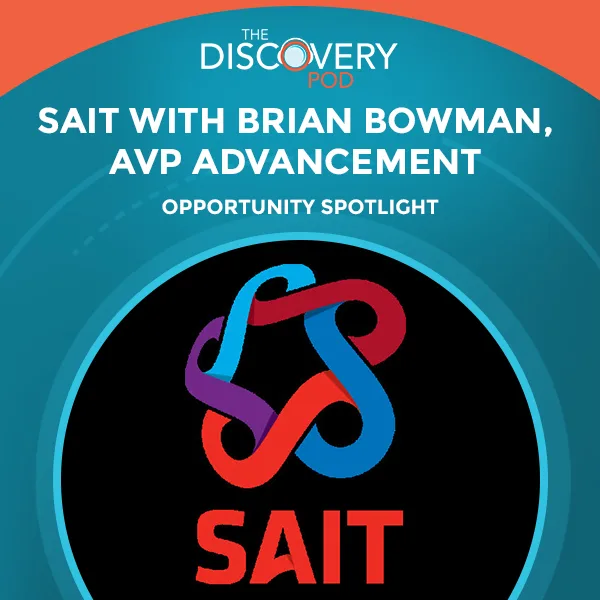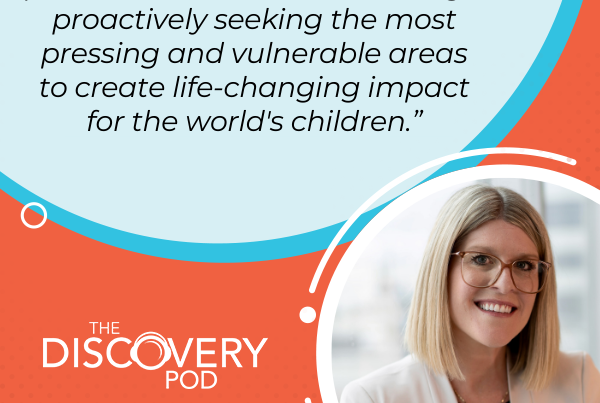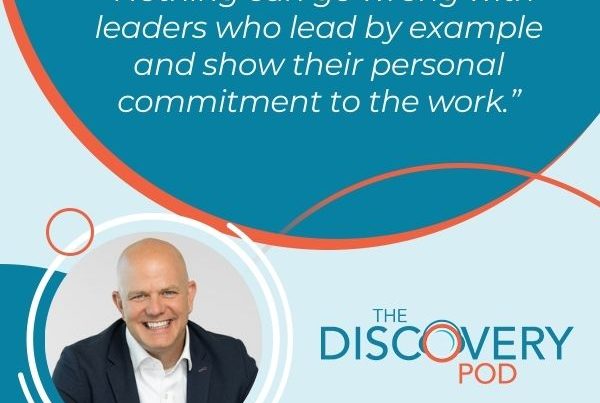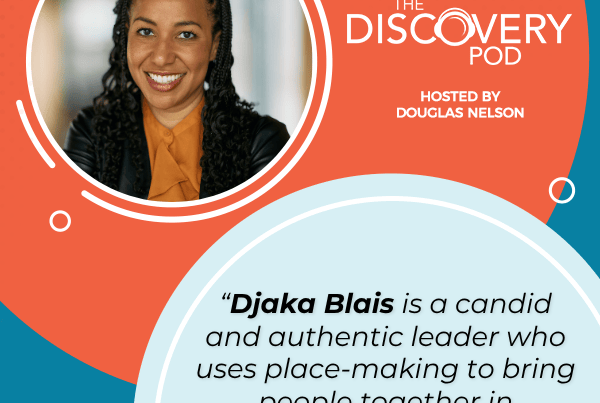
The future of education isn’t about stockpiling knowledge; it’s about building bridges between classrooms and boardrooms, between theory and practice, and between students and the careers waiting to be shaped by their potential. In this episode, Brian Bowman, the AVP Advancement of SAIT, shares the direction SAIT is taking to help you launch your industry engagement career. SAIT, a renowned polytechnic institute in Canada with a 100-year history of excellence, is seeking a passionate leader to establish its first-ever Industry Engagement Office. This is your chance to not just build a career but to build something entirely new. Be a part of shaping the future of education and industry collaboration in Canada. Join Brian Bowman in today’s inspiring conversation.
—
Listen to the podcast here
SAIT With Brian Bowman, AVP Advancement
I’m honored to have Brian Bowman, Associate Vice President Advancement, from the Southern Alberta Institute of Technology, or, what everybody lovingly knows is SAIT. Join me. We’re going to talk about the new director of industry engagement role that’s being created at SAIT. Welcome, Brian.
It’s good to be here. Thanks for having me.
Not at all. My pleasure. I’m looking forward to our discussion and talking about this new and creative role that you’ve developed, you and your team, for that matter. Before we dive in, maybe let’s talk a little bit about SAIT. I think most of the people listening are going to know about SAIT. They’re going to be relatively familiar with it, or at least have some understanding. Maybe you can tell me a bit more about SAIT.
It’s been around for a long time. It was founded in 1916. We celebrated our 100th birthday, and over the period of that time, we’ve generated somewhere in the neighborhood of now 280,000 alumni who are out working in various occupations but well known in terms of our trades skills training. We go far beyond that. There’s a lot of activity going on in areas like Applied Research. We have a very robust school of business. The activities that keep our faculty, staff, and the organization moving forward are supplying the talent that the industry needs.
Over the course of time, that changes, but to the point that we’re talking about in respective industry engagement state is long known as being an engine of industry in the sense that you cannot operate and build a business if you don’t have the talent and skills that are required to do the work. We’re part of that essential workforce and workforce training that everybody relies on.
Every time I talk to anyone from SAIT, for that matter, I’m always more impressed with the breadth and depth than the kinds of programs you’re doing. Personally, I’m a big fan of your culinary programs. That’s another conversation for another time, for that matter. What about you? What is your why? Why is it you do the work you do?
I love the post-secondary environment, first of all. Secondly, SAIT has a niche in the sense of being the salt of the earth and grounded in practical training that I can relate to. My dad was a steelworker and did that for somewhere in the neighborhood of 40 years, and my brother ended up being an electrician. I have a deep appreciation for the people who use their hands and hearts to build things, fix things, and make things, and as an ultimate purpose, is dedicated to supporting the successful lives and careers of our graduates.
Where I sit in the organization is facilitating that in the best way possible in terms of bringing resources to the table, relationships, industry connections, employment opportunities, bringing alumni back into the organization, and finding ways by which they can add value. The work that I do is incredibly fulfilling. It inspires me every day to hear some of the stories from our students, both in terms of the challenges that they have overcome, but also in many respects. Oftentimes, as we keep in touch with our alumni, there are significant achievements. It’s quite a remarkable place.
Speaking of remarkable places, you’ve been a remarkable member of the SAIT community for a few years now. What are you most proud of? Are there a few particular highlights that you think about when you think about SAIT and your work there?
So much to answer that question by, if I think about my early days, and I have been at SAIT for many years. I joined SAIT as part of the Promising Futures campaign, and incredible that we built a massive complex of 750,000 square feet called the Trades and Technology Complex with the support of many individuals in the community. We ran a campaign that raised over $100 million. That pales in comparison to fundamentally what I think I am most proud of, which would be building a team that I have incredible respect for and a team that is respected across the organization and, I think, in the community more broadly.
It’s working with that team and with those individuals that we’ve brought in, senior leaders, senior volunteers, and whatnot in the community to achieve great things. You can get good, and good is all right, but we’ve been able, in many cases, to achieve. It’s that combination of a team that’s inspired and engaged, and working, and with our alumni and members of the community who are also passionate about what we’re doing and helping us out.
That Good To Great analogy is important, particularly in regards to culture, having people want to be there, and having some devoted and contributing staff members. I want to pivot to that. The question I get from candidates all the time, people who are interested in the role, “Tell me what the work culture is.” What’s it like to work SAIT? What’s this Brian Guy like? Tell me about the culture at SAIT. How do you reflect on that?
Centralized Advancement Operation
SAIT is an interesting place, and if many of our readers have worked in a post-secondary environment, ours is somewhat decentralized in the sense that everything is operated out of a variety of schools, but our advancement operation is centralized. We don’t have an advancement team in each school, per se, as many universities do. The culture of SAIT is grounded in this strong industry connection, but also a relation to the curriculum that we’re delivering. We’re problem solvers. We love to identify problems, dig in and find solutions to find the fix, and to get things done. We’re high achievers. We have great aspirations. We probably have more aspirations than we have the capacity to be able to deal with.
It’s not always a bad thing, but in doing so, it’s an environment in which people collaborate together and help each other to find those solutions, “How can I contribute to making your initiative a success? What do I know as a subject matter expert that can contribute to the success of the team?” In all of my experience across the board in many years, SAIT is a very respectful place that takes its place seriously and appreciates the resources that advancement brings to the table.
It’s certainly a respectful place. When I speak to deans and other leaders at SAIT, people talk a lot about the collaborative mindset. I like how you approach that grounded in problem-solving and the desire to move things ahead and help each other out in that respect. That’s exciting. I think you of moving things ahead then. Let’s talk about the director of industry engagement role. It’s a new role newly created in your portfolio, but created with the collaboration of others on campus. Let’s talk about that. Why this role? Why now?
For probably a decade, I have been paying attention to the relationships that we enjoy with industry. They’re very strong. We engaged with Deloitte about many years ago to conduct a survey in an audit of our industry relations across the institution. We’re perhaps surprised to learn that there are more than 10,000 individual, unique relationships. What’s interesting is over the course of time, and you can imagine over 107 years to balloons, where is the coordination and how is a strategy being applied to the management of those relationships? Coming from a fund development background, we all know about prospect management, relationship management, and all those kinds of things in terms of moves and relationship building. However, at an institutional level or an enterprise level, the same discipline is very difficult to apply.
In learning more about the profession of industry relationship building and/or what we would call corporate engagement, I have discovered that there is some science and some methodology here that have been tried in a number of institutions. My passion here is about the idea that we can be more strategic and bring greater value to the industry if we are managing relationships that are both contributing creator value to the industry while at the same time serving the priorities and needs of the institution. This role comes in as a manifestation of SAIT’s strategy to blur the lines between the SAIT industry, recognizing how important and vital to our success and our student’s success having strong relationships with the industry is, while at the same time saying, “We can do a better job of that,” and doing improve the results that we’re getting for our students and add value.
In this environment with such significant change taking place in industry with digital transformation, with artificial intelligence, and all of the things that we all know about, there’s a real shift in terms of the needs of the industry to bring talent in that is relevant to where they find themselves. Part of the exercise here is about open dialogue and communication between the environments of business and the environment of education to find those connections and to mobilize and move forward in areas that are specifically going to have an impact on business success, economic success, and ultimately, of course from our stake is student success.

Industry Engagement: Find connections, mobilize, and move forward in areas that will impact business, economic, and student success.
I love the analogy of blurring the lines. It’s one that comes up a lot, certainly that navigation role between what can be perceived as very disparate industries and sectors, as you say, education, both secondary education and industry, but an organization like SAIT is well-positioned to do that fundamentally, and this person will be well positioned to do that. In this role, with that context, what do you envision this person doing? Map out for me some potential activities a day in life. How might this person approach the work, fundamentally?
Moving Individuals And Industry Relationships
If I think about an experience that I’ve had in trying to manage this expectation of what industry engagement is going to bring to the table at SAIT, what’s going to change as a result of it? It can be overwhelming. One of the key takeaways for me in terms of the studies that we’ve done and the evaluation and conversations with my colleagues on campus is we can’t boil the ocean. We don’t have any intention of managing 10,000-plus relationships. That means we need a strategy. That strategy is grounded in the idea that we’re moving individuals and industry relationships from, let’s call them transactional relationships, where they’re one-offs and they occur on a regular basis, to what our most valued relationships would be, which are those that are highly strategic and multi-dimensional.
Where this position will sit is taking a look at that vast landscape and looking at some of the sweet spots that are aligned to institutional priorities and meeting the industry’s most pressing needs, and finding the connections between those. This individual is going to be very interested in trying to evaluate the landscape and then determining how are we going to hone in on this and apply ourselves, to achieving the results. The two prongs that I would say are going to be a focal point in the first 3 to 6 months are going to be internal fortification and then moving into external activation.
We have to get our internal house in order, and we use the term One SAIT. We have to approach this from an enterprise level in approaching our relationships with industry, not from a school-specific or program-specific perspective, but rather from an institutional perspective. We have much to offer. We have many resources and subject matter expertise; we have a lot of facilities; and so on, that, I think in many cases, the industry is not aware of.
We first have to understand institutionally what is the purpose of industry engagement, getting everybody on board, building the infrastructure to support that, and then, to some extent, simultaneously with that is building the bridges and connections to industry in ways that make sense. We’ve got very strong relationships in existence with Calgary Economic Development, the chamber of commerce, with various industry associations. We want to leverage those and move those forward as well.
A day in life is going to likely involve a lot of meetings with people on campus, understanding what they do, what the products and services they’re offering, what their viewpoints on industry engagement, and so on. Bringing that back to the table and it’s relationship building to start, and then leveraging those relationships as we move forward.
As you said before, with over 10,000 pre-existing relationships already in existence, this person is not going to be starting from scratch fundamentally, but making sure that people have an understanding internally before those conversations happen is going to be a key piece, or at least doing simultaneously in the right way.
I wanted to add to that and say it is not starting from zero. We do have some great infrastructure already in place that the individual will be taking advantage of.
The rigor you’ve put behind this in terms of the Deloitte study that you mentioned, CRMs, and development, like the community buy-in that you’ve built across campus, is something. It’s a new role, but it’s not a new initiative fundamentally in some ways.
Moving a bit more to the abstract, perhaps, when you think about the ideal candidate, what are the traits, competencies, and background that you might look for in a new director?
There are many individuals that I can point to that is ideal. For those that are reading, I don’t think that there is a particular individual or characteristic, but I would say a fundamental trait would be a massive appetite for curiosity, a natural relationship builder, and somebody who’s comfortable in meeting new people and working a room, an individual who is able to follow through on the connections that have been made.
That means we’re diligent about the work that we do, taking some of those skills that would be applied in a sales or a fund development arena and applying them to this initiative and bringing to the table a personality that is trustworthy and grounded in discipline but is able to connect the dots between this amazing institution with many different facets, programs, services and match those to where it is industry might derive benefit. It’s a unique skill set that is going to be successful in this role. I do think there’s an individual out there who is absolutely at the point in their career where this is the natural next step for them.
I look forward to talking to them, for sure. One point I want to bring up as you alluded to before, is that the culture of SAIT is around problem-solving and being very solutions-focused for that matter. That’s a key piece, I think, for this person, but it’s implicit within your point, certainly as well in connecting those dots and being diligent, and so on. Fundamentally, for this person, these people that we’re talking about here, why would they want to leave their potential roles? Why would they want to join you at SAIT? What do you think is most compelling for someone to come join? Certainly, you paint a very compelling picture, but explicitly, what’s the case for the role of someone joining you?
I’ve drunk the Kool-Aid. The greatest draw here is the ability to create something that is not in existence currently. If there’s a builder and somebody who’s got a passion for creating something and building the structure to support it, this is for that kind of individual. As we build out the industry engagement office, jumping into the SAIT arena is an incredibly dynamic place. It’s exciting. No two days are the same. The environment in which we operate is beautiful. We’ve got a gorgeous campus with state-of-the-art facilities, and we’re an amazing team.
The greatest draw here is the ability to create something that does not currently exist. Share on XI am very proud of my team. It is noted and has won awards. In fact, in terms of our leadership and the work that we do, I would hold a candle to any organization and say, “We’ve built a solid culture within alumni development and the advancement team.” I know it will also be the case for industry engagement. It’s going to be a fantastic and very rewarding fulfilling career for someone.
I appreciate that you’ve drunk the Kool-Aid and I’m there with you to some degree. That said, what excites you about the future of SAIT? What’s coming up on the horizon that you’re most keen about besides the director role?
I have a lifelong interest in this notion of leaving an institution better than I found. In this particular case, industry engagement and seeing this office and the work of industry engagement, taking place on campus is going to be definitely a dream fulfilled. We have a number of other very exciting things underway. They do involve fund development activity and industry engagement activity. We are reconstructing, we’ve torn down, and will be rebuilding the campus center project on campus. That’s incredibly exciting. It’s going to facilitate some new teaching and learning spaces. It’s very student-centered.
There will be great opportunities for the industry to integrate with students via student clubs and whatnot in that facility. In support of that, we are undertaking a $125 million campaign as well to assist us, not just in the construction of the new campus center, but beyond that, it’s about how we teach, who we teach, and what we teach, including digital transformation. As I said before, there’s never a dull moment at SAIT, and there are many balls in the air right now. It’s such a transition as our student demographic shifts, as industry needs are changing, as our economy diversifies. There are many things to look forward in terms of continuing to advance and move the institution forward.
That’s a note to end on, for that matter. Any final messages for potential candidates, curious people, or readers who want to learn a little bit more?
Anybody who has even the smallest tinge of interest in this role, I would encourage them to take a deeper dive, have a conversation, and find out more about what we’re talking about in terms of this very exciting and unique opportunity. I don’t think that you’ll find something quite as interesting from a building and dynamic perspective for somebody who’s looking to apply their skills to something that hasn’t existed before. Probably will be a flagship amongst polytechnics in colleges in Canada.
When I do my preliminary research, at least, and nobody’s doing it to this degree or coming up with this solution, it’s very exciting. I’m keen to dive in, for that matter. I know the postings on your website, it’s on our website. You can reach out to me directly at [email protected], via LinkedIn, or whatever works for everybody. We’re not inaccessible by any means. Thank you for your time, Brian. I’m enjoying working with you on the search and looking forward to sitting down with some candidates, diving in, and learning more about who’s out there who’s interested.
I can’t wait to meet them. Thanks.
My pleasure.
Important Link
- Southern Alberta Institute of Technology
- Good To Great
- [email protected]
- LinkedIn – The Discovery Group




